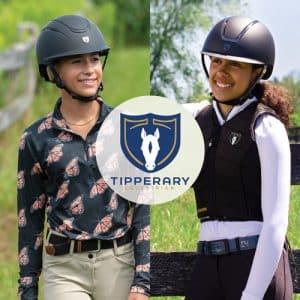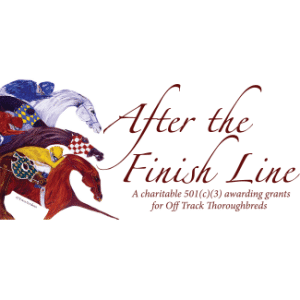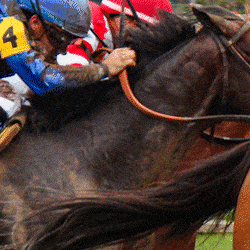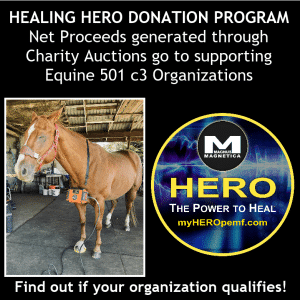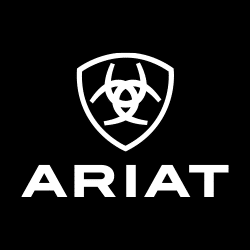What to do if your new off-track Thoroughbred doesn’t know longeing basics
Transitioning an off-track Thoroughbred is a lot like an archaeological expedition: You might have to dig a bit to figure out what he knows, because no two race training programs are exactly alike. This is especially true when it comes to longeing.
Some Thoroughbred farms employ a training staff that teaches youngsters solid basics in what amounts to racehorse kindergarten. Others get started in stock saddles by cowboys or natural horsemanship trainers. Still others “learn while doing” at the track, where they might get a good “whoa and go,” but not a whole lot else. That means your newly off-the-track horse might know how to politely go around in a circle on a longe line. Or not.
When I bought 4-year-old Blushing Ann (Street Boss — Jettie Ann, Bertrando), I didn’t know much about her history beyond her race record, and she came to me directly off the track, race fit and raring to go. Based on my previous OTTB experience, I figured I had about a 25% chance she would know what I wanted when I sent her to the end of my long cotton rope. She took a couple trepidatious steps and bolted, ricocheting off the end of the line while I dug my heels into the sand.
Well, we had something to work on.
Starting at the Beginning
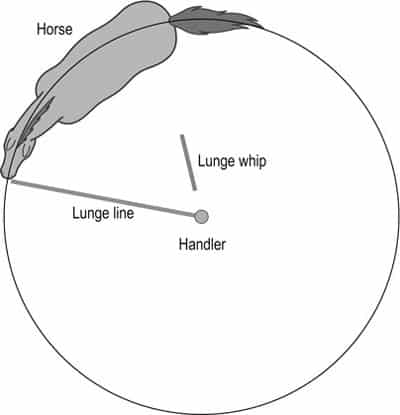
My experience with Ann isn’t unusual for OTTB owners when they get their new horses, says trainer Marissa Nielsen, who operates Black Diamond Equestrian, in Plymouth, California. Nielsen competes at the FEI levels in eventing, is a Grand Prix show jumper and has earned a U.S. Dressage Federation bronze medal. She also galloped horses on the track and has restarted numerous OTTBs. I sent my “Ann” to Nielsen for training to begin an eventing career.
When assessing your new OTTB Nielsen recommends starting at the beginning.
Longeing is the act of moving a horse around you on a long line or rope, usually 10 to 30 feet in length, which is attached to a halter, longeing cavesson or bridle. “Free longeing” is done sans rope, usually in a round pen. For both, the handler stays in the middle of the circle while using voice commands and body language to drive the horse around her at a walk, trot and canter.
There are many benefits to longeing, Nielsen says, “No. 1 being safety (for the rider by allowing the horse to expend extra energy), as well as fitness, evaluating soundness and training. Respect starts from the ground up, and if you establish yourself as the leader on the ground, you can stay safe.”
Safety should be your priority when teaching any horse to longe, says Nielsen, who learned to longe horses “the Pony Club way” and graduated from the organization with her “A” certification. She recommends:
■ Wearing gloves to give you better grip and protect your hands from rope burns if the horse bolts;
■ Wearing a helmet to protect your head in case the horse kicks or strikes;
■ Selecting an appropriately long line so you can move out of striking or kicking distance;
■ Using a whip or training stick long enough to keep your horse at a safe distance (“I’ll take both with me and put one on the ground so I can switch if I need to,” Nielsen says.); and
■ Practicing rope handling to ensure you can manage adjusting its length without getting your hand looped in the line or having it tangle around your feet or legs. That way, if the horse were to bolt, you reduce the risk of serious injury to your limbs or the potential of being dragged.
If you are new to longeing, practice with a trained horse or seek the help of a professional before trying it with your OTTB.
The First Time on the Line
With any horse groundwork becomes the foundation of longeing.
First the horse needs to learn to yield its shoulders and hips to you, Nielsen says. This means when you walk toward the horse’s hip, he should step his haunches away from you while turning on the forehand. When you step toward his shoulder, he should step away with his front end while turning on the haunches.
Ideally, moving the horse’s body will organically flow into the horse moving his feet and circling around you as you drive him forward by moving behind his withers, pointing your whip or stick at his hip while creating an “open door” for him to step into with your leading hand (your right hand if the horse is moving clockwise and your left hand if the horse is moving counterclockwise). In a perfect world this dance between horse and handler happens at the walk, and as you drive the horse out, you urge him into a trot and then a canter by increasing your energy, using voice commands and moving farther back toward his hip to drive him forward and faster.
As a nonprofessional, I’m always surprised by how quickly a youngster figures out what you want during longeing lessons and obliges. With horses I’ve raised, teaching them to longe has been so easy I’ve wondered if someone sneaked into the barn and practiced with them at night when I wasn’t watching (they hadn’t).
“But with an OTTB you have to remember you’re not starting with a blank slate,” Nielsen says. “They come with habits.” And energy.
When I describe my first time longeing Ann, Nielsen nods knowingly. “That sounds about right,” she says.
I started Ann in a flat halter, which ended up rubbing on her face as she blasted around me. Seeing the problem, I immediately moved her into a Micklem Multibridle, which has a longeing ring on the noseband. Nielsen says she prefers using a rope halter for groundwork and to begin longeing.
“A rope halter is the way to go, all the way,” she says. “It helps teach them to move away from pressure. Then they can graduate to the Micklem (Multibridle) like you used or a longeing cavesson before a bridle.”
While OTTBs are used to bits, Nielsen doesn’t recommend starting their longeing training in a bridle with the longe line attached to the bit or through the bit and over the poll. “I find this makes them hard in the mouth later,” she says.
Some trainers start by free longeing in a round pen without a line, teaching the horse to move in a circle before adding pressure. Nielsen, however, recommends starting your OTTB’s longeing lessons with a longe line in a 50- or 60-foot-diameter round pen, which offers a confined space for learning. With time, once your OTTB is confirmed on the longe line and comfortable with his new work and environment and you better know his personality, you can add free longeing to his repertoire.
The Next Step
Once OTTBs understand how to longe, Nielsen says she moves them into loose side reins within a couple of training sessions. She does this by outfitting them with both a bridle and a rope halter. She attaches the side reins to the bit from the saddle or surcingle, but she attaches the longe line to the rope halter. This allows them to work on light, consistent contact with their bodies straight or gently arcing on the circle.
“You have to remember that the closest thing to longeing many racehorses have done is going on a hotwalker,” Nielsen says.
This means an OTTB is likely to longe with his body crooked rather than in an arc. He might also think it’s playtime, but Nielsen stresses longeing should be worktime — and the horse definitely shouldn’t be allowed to kick at his handler. “They need to learn to go straight and with contact,” she says. Hearing Nielsen say this was an aha! moment, as I remember Ann galloping around me sideways until I put her in a saddle and side reins.
Once Ann understood how to longe calmly in her training bridle — which took three to five sessions — we worked on voice commands, including the all-important “whoa.” Ann was especially ticklish, so I practiced gently looping soft cotton lines around her and having her drag ropes so she got used to the feel and sound of them moving against her body, legs and ground. Once she was comfortable with those exercises, she graduated from longeing to long-lining and ground-driving. When I sent her to Nielsen to start her training over fences, the pair returned to those foundational ground exercises and longeing to establish their relationship. And now, two years after leaving Emerald Downs, Ann is handily hopping around full jumper courses.
Take-Home Message
Longeing is an important part of a sport horse’s educational foundation. Your newly off-track Thoroughbred may or may not have been taught to longe in his early training and, even if he has, might need a refresher on how to do so. Training an ex-racehorse to longe will help establish your relationship, give you a tool to help him expend energy and offer the opportunity to train from the ground before getting on his back. If you aren’t an experienced longer, seek a trainer’s help.
This article was originally published in the Fall 2020 issue of Off-Track Thoroughbred Magazine, the only publication dedicated to the Thoroughbred ex-racehorse in second careers. Want four information-packed issues a year delivered to your door or your favorite digital device? Subscribe now!

